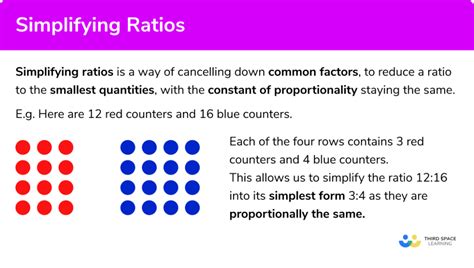Ratios are a fundamental concept in mathematics, and understanding how to simplify them is crucial for solving various mathematical problems. Simplifying ratios involves reducing them to their simplest form, making it easier to compare and work with them. In this article, we will explore five ways to simplify ratios, along with examples and explanations to help you master this essential math skill.
Understanding Ratios

Before we dive into simplifying ratios, let's quickly review what ratios are. A ratio is a comparison of two numbers by division, often denoted as a fraction. For example, if we have 12 apples and 8 oranges, the ratio of apples to oranges is 12:8 or 12/8. Ratios can be used to describe proportions, rates, and scales in various real-world contexts.
Method 1: Finding the Greatest Common Divisor (GCD)

One way to simplify ratios is to find the greatest common divisor (GCD) of the two numbers. The GCD is the largest number that divides both numbers evenly. To simplify a ratio using the GCD method:
- List the factors of each number.
- Identify the greatest common factor.
- Divide both numbers by the GCD.
Example: Simplify the ratio 24:36 using the GCD method.
- Factors of 24: 1, 2, 3, 4, 6, 8, 12, 24
- Factors of 36: 1, 2, 3, 4, 6, 9, 12, 18, 36
- GCD: 12
- Simplified ratio: 2:3 (24 ÷ 12 = 2, 36 ÷ 12 = 3)
Benefits of Using the GCD Method
- Easy to understand and apply.
- Works well for simple ratios.
Method 2: Using Prime Factorization

Another way to simplify ratios is to use prime factorization. This method involves breaking down each number into its prime factors and then canceling out common factors.
- Factorize each number into its prime factors.
- Identify common prime factors.
- Cancel out common prime factors.
Example: Simplify the ratio 48:72 using prime factorization.
- Prime factors of 48: 2 × 2 × 2 × 2 × 3
- Prime factors of 72: 2 × 2 × 2 × 3 × 3
- Common prime factors: 2 × 2 × 2 × 3
- Simplified ratio: 2:3 (48 ÷ 24 = 2, 72 ÷ 24 = 3)
Benefits of Using Prime Factorization
- Works well for complex ratios.
- Helps to identify common factors.
Method 3: Using Equivalent Ratios

Equivalent ratios are ratios that have the same value but different numbers. To simplify a ratio using equivalent ratios:
- Find an equivalent ratio with smaller numbers.
- Simplify the equivalent ratio.
Example: Simplify the ratio 12:18 using equivalent ratios.
- Equivalent ratio: 6:9 ( multiply both numbers by 0.5)
- Simplified ratio: 2:3 (6 ÷ 3 = 2, 9 ÷ 3 = 3)
Benefits of Using Equivalent Ratios
- Easy to apply.
- Works well for simple ratios.
Method 4: Using the Least Common Multiple (LCM)

The least common multiple (LCM) is the smallest number that is a multiple of both numbers. To simplify a ratio using the LCM method:
- Find the LCM of the two numbers.
- Divide both numbers by the LCM.
Example: Simplify the ratio 16:24 using the LCM method.
- LCM: 48
- Simplified ratio: 1:3 (16 ÷ 16 = 1, 24 ÷ 8 = 3)
Benefits of Using the LCM Method
- Works well for complex ratios.
- Helps to identify common multiples.
Method 5: Using Decimal Division

Decimal division involves dividing both numbers by a decimal value to simplify the ratio.
- Divide both numbers by a decimal value.
- Simplify the resulting ratio.
Example: Simplify the ratio 12:18 using decimal division.
- Divide both numbers by 0.5: 12 ÷ 0.5 = 24, 18 ÷ 0.5 = 36
- Simplified ratio: 2:3 (24 ÷ 12 = 2, 36 ÷ 12 = 3)
Benefits of Using Decimal Division
- Easy to apply.
- Works well for simple ratios.
Now that you've learned these five methods for simplifying ratios, practice them with different examples to become more proficient. Remember to choose the method that works best for the specific ratio you're working with.
We hope this article has helped you understand the concept of simplifying ratios and provided you with practical methods to apply in various mathematical contexts. If you have any questions or need further clarification, please don't hesitate to ask.
What is a ratio in mathematics?
+A ratio is a comparison of two numbers by division, often denoted as a fraction.
Why do we need to simplify ratios?
+Simplifying ratios makes it easier to compare and work with them, as well as identify patterns and relationships.
What is the difference between the GCD and LCM methods?
+The GCD method involves finding the greatest common divisor, while the LCM method involves finding the least common multiple.
